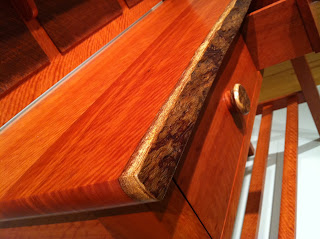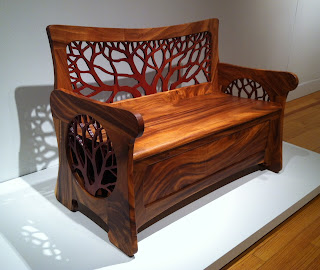In the previous post, I highlighted some of the pieces I recently viewed at the "Finding the Forest" woodworking show in Hawaii. It has been difficult to get all of those images out of my head! Especially this one!
 It was taken on Big Beach; that island in the distance is Kahoolawe, a mostly deserted island off the southwest side of Maui. This island was used as a training ground and bombing range by the military, but after decades of protests, the Navy stopped these practices in 1990.
It was taken on Big Beach; that island in the distance is Kahoolawe, a mostly deserted island off the southwest side of Maui. This island was used as a training ground and bombing range by the military, but after decades of protests, the Navy stopped these practices in 1990.
Here is my most place in the world, don't you just love photo-stitching software?
Here is part two of the "Finding the Forest" woodworking show in Hawaii. I've saved the best (in my friend Kai's and my opinion) for last.
Tai Lake's piece - It's hard to see the forest for the needs - voiced his feelings about our interdependence upon forests.
He included small vignettes showing how wood is harvested
and often wasted. This mixed media piece included woods, metals, glass and milk paint, and was quite a lovely statement of man's forest abuse and the need for creating a balanced and bountiful forest.
Similarly, Ricardo Vasquez's work, entitled "Gift of Life" explored the connection the forest and life.
In his statement, he mentioned that tree growth rings kept coming to his attention while designing this piece, and his use of stacked marine plywood illustrated this beautifully.
This piece flowed nicely, and reflected the "wisdom of the Hawaiian people and their connection with the physical and spiritual world of the forest."
Mats Fogelvik took a more traditional woodworking approach, designing and building this lovely Koa burl veneered table.
The manner in which he veneered the top was amazing, his use of this rare material was stunning. This wood was salvaged from a downed tree! Add to that - his finish was impeccable. This was a lovely piece, fully utilizing the beauty of this lumber.
I loved the playfulness of Chris Reiner's "Incisor Debris Finder," which started with a 1960's Electrolux vacuum cleaner. In one end - a twig is fed,

and out the other comes batches and batches of toothpicks and small logs. And sawdust - lets not forget that.
This piece spoke volumes about the dwindling resources in our forests, and - as Chris writes - " our insatiable appetite for wood."
Finally - the best for last. At least, in my head.
Jay Warner's piece in Murray River Gum is everything in a piece of furniture that should be. Murray River Gum is in the Eucalyptus family, and is commonly known as a widow-maker tree, likely to drop huge branches on unsuspecting people who happen to be standing in the wrong place at the wrong time. It's Mother Nature's way of tree-trimming, but with deadly results.
This sideboard, entitled "The Gift" was understated and nothing short of spectacular in its simplicity.
Trust me, if life was simple and money not an object, this piece would be sitting in my home right now. I've always felt that a true sign of a successful piece is if another woodworker would want to purchase it. In this case - hell yes.
This piece featured a live edge front, as well as knobs hand turned, with bark still on them.

The wood had a tiger-striped figure, and almost glowed from his treatment to it.
The backsplash had three roughsawn panels on it, and the contrast if texture was stunning.
The drawers were made with sliding dovetails, and it was all I could do to keep myself from touching this piece all over. Of course, the gallery monitors kept and eye on us, and we couldn't sneak a single feel.
I didn't plan this vacation around the scheduling of this woodworking show, but I sure am pleased that I was able to catch it while in town. It was interesting to see these woodworkers' use of precious materials, and it bought up two thoughts - it's a shame that they're working with such limited resources.
But - at the same time, it's nice to know that they're not blind to the conditions and availability there. Every woodworker I've spoken to there seems to be working hard to do their part to replenish the forests. That awareness in itself is a huge first step to solving this shortage.
Congrats to all of these woodworkers. I'm humbled to be in their company!































































